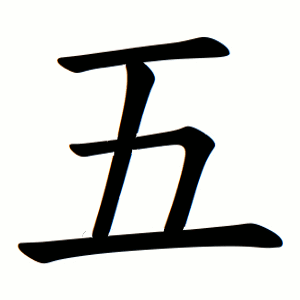五
- five, number 5, fifth;
Etymology
五 is an ideogram, and notably, it's the first numeral character that breaks the original character formation principle used for earlier numerals.
For the numerals 1 to 3:
一, 二, and 三 directly depict the quantity by drawing 1, 2, and 3 horizontal lines respectively.
四 also followed this principle in its ancient form 亖, which consists of two stacked "二"s.
However, from five onward, this design principle becomes inefficient—adding more strokes for larger numbers becomes unwieldy. As a result, 五 breaks from this direct representation style.
The origin of 五 is generally thought to come from modifying the form of 亖 (four). Specifically:
The two middle strokes in 亖 were crossed into an X shape, symbolizing the transition from 4 to 5.
This change marks a shift in how Chinese numerals were constructed—from visually representing quantity to symbolic representation, starting with 五.
- 一木一 (MDM)
- ⿱ 一 𫝀
- ⿻ 丅 ユ
- ⿻ 工 𠃍
